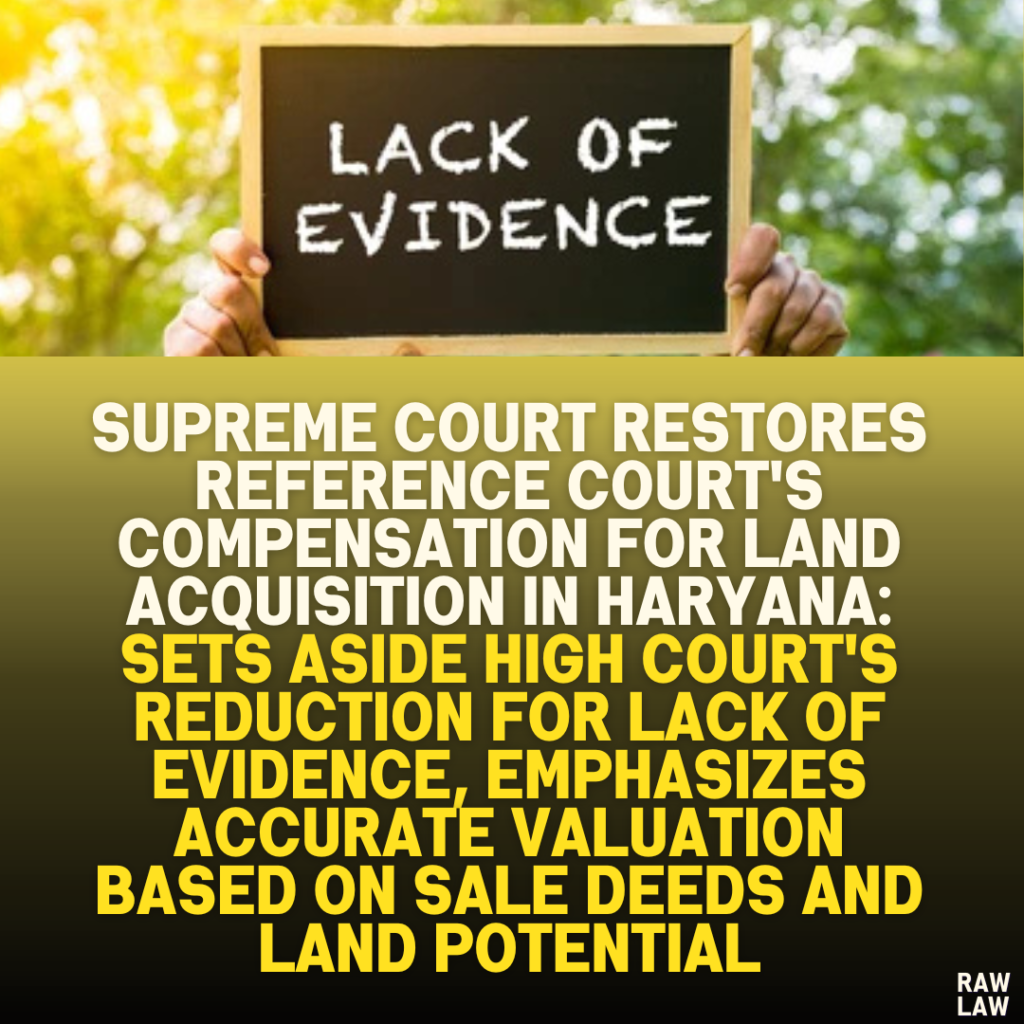Court’s Decision
The Supreme Court allowed the appeal and restored the compensation amount granted by the Reference Court for the land acquired in Village Tauru, District Mewat, Haryana. It held that the High Court erred in reducing the compensation and emphasized the need for accurate compensation aligned with evidence of sale deeds and land potentiality. The Court directed that if the compensation amount has not been paid (wholly or partly), it must be paid within eight weeks, along with all statutory benefits and interest.
Facts
The appellants challenged the decision of the High Court, which had reduced the compensation for their land acquired under the Land Acquisition Act, 1894. The land, located in Village Tauru, District Mewat, was acquired through notifications issued on 11.02.2011 and 10.02.2012 under Sections 4 and 6 of the Act.
The Reference Court, relying on evidence such as sale deeds and the land’s potential, had granted compensation at a higher rate. The High Court, however, reduced the amount, prompting the appellants to approach the Supreme Court.
Issues
- Was the High Court justified in reducing the compensation awarded by the Reference Court?
- Did the Reference Court properly evaluate the evidence, including sale deeds and potentiality, to determine the compensation?
Petitioner’s Arguments
- The appellants argued that the Reference Court had conducted a thorough analysis of the evidence, including sale deeds and the land’s development potential.
- They contended that the High Court’s decision to reduce the compensation was arbitrary and failed to consider the principles laid down under the Land Acquisition Act.
- The appellants also relied on the Supreme Court’s earlier judgment in Horrmal (Deceased) Through LRs v. State of Haryana, which dealt with similar circumstances and upheld the Reference Court’s findings for the same acquisition process.
Respondent’s Arguments
- The respondents supported the High Court’s reduction of the compensation, arguing that the Reference Court had relied on flawed sale exemplars (e.g., Ex. P76) that were commercial in nature and not directly comparable to the acquired agricultural land.
- They asserted that the High Court had acted within its jurisdiction to correct errors in the Reference Court’s assessment.
Analysis of the Law
The Court analyzed the following key aspects of the law:
- Principles of Fair Compensation: Under the Land Acquisition Act, compensation must reflect the fair market value of the land, considering factors such as sale deeds, future potential, and other evidence.
- Role of Reference Court: The Reference Court’s valuation carries significant weight if it is backed by evidence and conducted with due diligence.
- Appellate Intervention: High Courts are expected to interfere with Reference Court awards only when there is a clear error or lack of adherence to statutory principles.
The Supreme Court noted that the Reference Court had relied on sale deeds and considered the land’s potential development. While the sale exemplar (Ex. P76) was not ideal, it was sufficient under the circumstances.
Precedent Analysis
The judgment in Horrmal (Deceased) Through LRs v. State of Haryana, which dealt with the same acquisition and set aside the High Court’s reduction of compensation, was instrumental in the Supreme Court’s decision. In that case, the Court upheld the Reference Court’s award, stating it was aligned with evidence and statutory principles.
The present case followed the precedent set in Horrmal, reinforcing that the High Court’s reduction of compensation was unwarranted.
Court’s Reasoning
- Error by High Court: The Supreme Court found that the High Court erred in reducing the compensation, as the Reference Court’s valuation was nearly accurate and aligned with evidence.
- Reliance on Precedent: Referring to its earlier decision in Horrmal, the Court emphasized that the Reference Court’s findings were more reliable and consistent with statutory principles.
- Fair Market Value Consideration: The Court highlighted that compensation must reflect the market value and development potential, as supported by sale deeds and other evidence.
The Supreme Court concluded that the High Court failed to justify its reduction of compensation and that the Reference Court’s award was fair and accurate.
Conclusion
The Supreme Court allowed the appeal, restoring the Reference Court’s compensation and setting aside the High Court’s reduction. It directed that any unpaid compensation, along with statutory benefits and interest, must be paid to the appellants within eight weeks.
Implications
This judgment reaffirms the rights of landowners to fair compensation under the Land Acquisition Act. It emphasizes the importance of evidence-based evaluations by Reference Courts and limits unwarranted appellate interventions. By upholding the Reference Court’s findings, the Supreme Court ensures consistency in compensation assessments and reinforces legal precedents for future cases.




Pingback: Supreme Court Recognizes Hypothecation Agreements as Financial Guarantees: Affirms Appellants' Status as Financial Creditors Under IBC, Strengthening Creditor Rights in CIRP - Raw Law